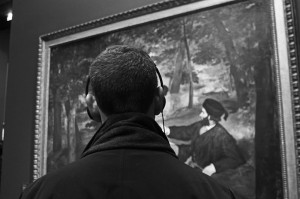I can’t count how many times I’ve sat in a classroom at my home institution thinking to myself ‘wow, there are so many other things I’d rather be doing right now...’ and I doubt there isn’t a student out there that hasn’t thought something similar at some point in time.
We all know the symptoms of the class that never seems to end–a dreary lecture hall, the quintessential PowerPoint slides of seemingly redundant information, un-enthused peers and perhaps an exhausted instructor. Now this isn’t meant to be a ‘diss’ of sorts to institutionalized learning, no not at all, but merely an observation that a lot of the time the classroom setting in at the average university can sometimes be less than stimulating. When you really sit back and look at the information that's being spewed out at you and regurgitated on your notes, some of it is actually pretty cool!
Whether you are studying genomes, African architecture, or animal psychology, almost every subject provides us as human beings, some level of fascination that leads us to want to discover more. That’s where the hard part comes in–how do we stir up that fascination? What’s the key ingredient to get us to want to discover more, and not because we’re forced to but because we develop a genuine curiosity. That’s where the living classroom comes into play and active learning in the context of studying abroad becomes extremely relevant.
For those of us that aren’t familiar with the term, active learning has to do with physically and/or mentally being engaged with the subject matter at hand. In other words, you are actually experiencing some element of what you are learning about firsthand due to geographic availability or the utilization of various other resources to bring subject matter to life.
An example would be that in the Oenology course (the science of wine-making) taught at the CEA Global Campus in Paris, the professor asks that students create delicate cuisines firsthand either in the classroom or outside of it to use as supplements to wine tasting. So instead of reading about the procedures and recipes that go into creating fine wines and the appetizers that enhance them, the students are creating it themselves, which further internalizes the subject matter at hand. By going out and experiencing the things that you’re studying you begin to develop multidimensional understanding of the topic that gives you a broader perspective–not only do you have textual knowledge in the form of facts and figures, but also hands-on experience, which will help bring your subject matter full circle.
Another great example of active learning and how it is fully embodied through study abroad would be with the study of art and literature. In my Photography in Paris course we have been reading Ernest Hemingway’s A Moveable Feast while studying various photographers’ work (some of whom spent time capturing Paris). Reading about Hemingway’s experiences in Paris while in Paris not only helps me comprehend his viewpoint in concordance with my own, but helps me synthesize the real images/places with his prose. Today, I can still frequent many of the roads, cafes, museums and parks that he so often wrote about, which is a privilege that students studying him elsewhere do not have.
There is something truly magnificent and moving about experiencing the same emotions or realizations as a the painter you’re studying in Art History because standing where they stood (as clichè as it sounds) fosters connection that transcends time as well as space.
Jerusaliem Gebreziabher is the Spring 2013 CEA MOJO in Paris
We all know the symptoms of the class that never seems to end–a dreary lecture hall, the quintessential PowerPoint slides of seemingly redundant information, un-enthused peers and perhaps an exhausted instructor. Now this isn’t meant to be a ‘diss’ of sorts to institutionalized learning, no not at all, but merely an observation that a lot of the time the classroom setting in at the average university can sometimes be less than stimulating. When you really sit back and look at the information that's being spewed out at you and regurgitated on your notes, some of it is actually pretty cool!
Whether you are studying genomes, African architecture, or animal psychology, almost every subject provides us as human beings, some level of fascination that leads us to want to discover more. That’s where the hard part comes in–how do we stir up that fascination? What’s the key ingredient to get us to want to discover more, and not because we’re forced to but because we develop a genuine curiosity. That’s where the living classroom comes into play and active learning in the context of studying abroad becomes extremely relevant.
For those of us that aren’t familiar with the term, active learning has to do with physically and/or mentally being engaged with the subject matter at hand. In other words, you are actually experiencing some element of what you are learning about firsthand due to geographic availability or the utilization of various other resources to bring subject matter to life.
An example would be that in the Oenology course (the science of wine-making) taught at the CEA Global Campus in Paris, the professor asks that students create delicate cuisines firsthand either in the classroom or outside of it to use as supplements to wine tasting. So instead of reading about the procedures and recipes that go into creating fine wines and the appetizers that enhance them, the students are creating it themselves, which further internalizes the subject matter at hand. By going out and experiencing the things that you’re studying you begin to develop multidimensional understanding of the topic that gives you a broader perspective–not only do you have textual knowledge in the form of facts and figures, but also hands-on experience, which will help bring your subject matter full circle.
Another great example of active learning and how it is fully embodied through study abroad would be with the study of art and literature. In my Photography in Paris course we have been reading Ernest Hemingway’s A Moveable Feast while studying various photographers’ work (some of whom spent time capturing Paris). Reading about Hemingway’s experiences in Paris while in Paris not only helps me comprehend his viewpoint in concordance with my own, but helps me synthesize the real images/places with his prose. Today, I can still frequent many of the roads, cafes, museums and parks that he so often wrote about, which is a privilege that students studying him elsewhere do not have.
There is something truly magnificent and moving about experiencing the same emotions or realizations as a the painter you’re studying in Art History because standing where they stood (as clichè as it sounds) fosters connection that transcends time as well as space.
Jerusaliem Gebreziabher is the Spring 2013 CEA MOJO in Paris











